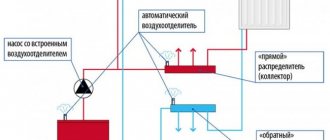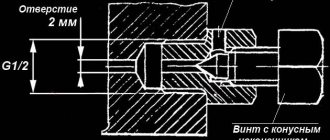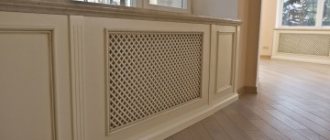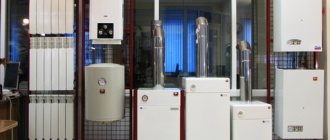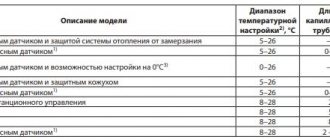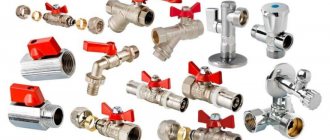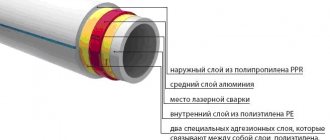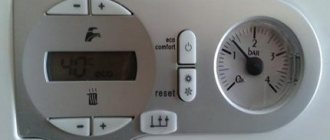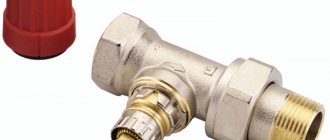Every year before the heating season, utility services notify citizens living in high-rise apartments that it is necessary to bleed air from the heating system. The reasons for the formation of air in the heating system are factors such as the release of hydrogen during chemical reactions, as well as repair work, as a result of which water is drained from the system. To remove air, special devices are used - air vents.
Air vents for heating systems are also called air release valves, without which it is impossible to ensure the normal functioning of the heating system.
Air in the heating system: causes
Air enters the heating system for a number of reasons:
- filling the line with water, resulting in the formation of air accumulation areas;
- violation of the quality of sealing devices;
- corrosion processes occurring inside pipelines;
- improper execution of installation work.
The main reason why it is necessary to remove air from the heating system is that oxygen contributes to the creation of air pockets. These plugs help reduce pressure and also reduce the rate of coolant circulation. If you do not bleed the air mixture in the heating radiators, you may experience a process such as a lack of heating of the battery sections.
What types of air vents are there?
Air vents are divided into two types:
- manual;
- automatic.
Manual products are designed to deflate air through human intervention. To do this, utility workers either independently go around all the apartments to carry out such manipulations, or inform the residents of the house. Automatic air vents for heating systems do not require human intervention, so they release oxygen on their own. The cost of such devices is several times higher than manual ones, so utility services are not able to provide all high-rise apartments with automatic air vents.
Automatic air vents are installed in places where there is a high probability of air lock formation. The locations for such devices are heating radiators.
What are the dangers of not having air vents?
Air vents are used not only in heating networks of multi-storey buildings, but also in private ones. Each radiator is equipped with an air vent, which is often presented as a manual type.
The air inside the heating system impedes the circulation of the coolant, which negatively affects the heating of the premises. If you do not bleed air from the system in a timely manner, vibration is created when the coolant heats up. This phenomenon can ultimately lead to physical damage to the heating network circuits. The main places of damage are the connection points of heating radiators, as well as welding or soldering seams.
If there is no air in the metal pipe circuit, then the internal walls of the pipelines do not corrode, unlike in cases where there is oxygen in the system. When the internal walls of pipelines rust, not only does the service life decrease, but also the coolant becomes clogged. Draining or bleeding air is a prerequisite, since residents of houses and apartments who ignore to carry out such a procedure themselves may be left without heat.
Types of locking mechanism
All existing heating air valves, sewerage or water supply can be divided according to the design of the locking mechanism. The following types are distinguished:
- Rotary. The models are fixed to the pipeline thanks to an insert. A spool or lever is used to control the air flow. When there is a strong influx of air, the spool turns and air passes through. This type is considered safe and reliable.
- Ball. Such valves are convenient for use on small diameter pipes. The mechanism consists of a ball and a spring, they control the flow of water and air. It is appropriate to use the devices on the system in front of the washbasin or shower.
- Lifting. If the apartment has a vertical riser with a wide pipe diameter, then a lifting type of locking mechanism will come in handy. The essence of the work is to change the position of the membrane made of polyvinyl chloride. The flow lifts the device from below, but reliable fasteners prevent it from rising back.
- Wafer. A small wafer-type air valve is mounted using a thread and can be used on plastic or metal water pipes. The flexible membrane is the working part of the mechanism; its position changes under the influence of water flow.
An example of installing a device under a sink.
A large selection of air valves can be found in plumbing supply stores. The buyer must decide in advance what type of product is needed for installation in the water supply, sewerage or heating system.
Features of the functioning of manual descenders
The design of the simplest manual air vent is shown in the diagram below.
This air vent is called the Mayevsky crane, the operating principle of which is very simple. The device has two holes that are covered by a threaded element. When unscrewing the threaded element, air is released, which is pushed through the 2 mm hole in the diagram above, and exits the system through the second hole.
To bleed air from the system, it is enough to make 2-4 turns of the screw, after which, under the pressure of the coolant, the air will tend to escape through the holes. You can know that all the air has been drained from the system by the appearance of water flowing out of the hole. As soon as a dense stream of water flows from the hole, you need to screw the screw in until it stops. Modern Mayevsky cranes are presented in various types: turnkey, with handles and even with a screwdriver. The photo below shows a list of such types.
A manual air valve in a heating system is an ideal device that functions flawlessly over a long period of time. The reliability of this device is due to the absence of moving parts, which over time are subject to clogging, corrosion and failure. This is typical for automatic air exhaust products.
Often, instead of Mayevsky’s manual taps, apartment owners install drainage taps. They can be installed temporarily, but not permanently, since they are not intended for installation on radiators. If such products fail, it will be very difficult to replace them during the heating season.
Ball
Sewage flooding is especially likely in high-rise buildings, where several apartments are located on one vertical pipe. Even one plastic bag may be enough to clog the riser, and then yes, not finding its way, will rush back, splashing out of all the drain holes. This situation is especially likely in old houses, where the pipes are covered on the inside with thick crusts of deposits.
The risk of backflow of waste water is especially high in apartments on the ground floor. Often at night in such apartments it is necessary to plug the drains with rags, plugs and other improvised plugs. But if valves are installed on the first floors, water can break through on the second floor. Up to the third floors, the pressure is usually not enough, and if it is strong enough, it will simply destroy the blockage and the water will go into the pipe.
So, it’s worth installing a check valve if:
- Your apartment is located on the first or second floor.
- You live in an individual home: a cottage, a dacha, a private house.
- The house was built a long time ago and there has been no major repair of the sewer system or replacement of risers.
- According to neighbors, there are frequent cases of sewer blockages in the house.
In this case, the small costs of purchasing and installing protective devices will pay off handsomely, allowing you not to worry about sudden costs and hassle.
If your home has a common riser valve installed, it can reduce the risk of flooding. But in problem apartments it is better to install separate valves on each drain to be completely sure.
Device
In 2022, there are many options for such a unit. They differ in materials, sizes and shapes, locking methods and many other parameters. But all types of valves have the same purpose - to cut off sewer water in the pipe that rushes sharply in the opposite direction.
Almost any design has the following elements:
- The pipes through which drained water enters and leaves the valve.
- A handle that closes the valve forcibly. It can be used when cutting off drains at night, or when trying to unclog a sewer system.
- A removable cover that allows you to inspect the condition of the valve and, if necessary, clean its parts from contamination.
- Locking mechanism. A ball valve is a rubber ball, but membranes, flaps and other devices can also be used.
The valve will not work if the “input” and “output” are reversed. Typically, the direction of movement of the drains in the valve is shown by an arrow marked on the body. Take this into account during installation!
How does an automatic air vent work?
Let's figure out how an automatic air vent works, the cost of which is 2-3 times higher than manual devices. Such products are equipped with air release valves that function without outside intervention. The design of the product is a vertical barrel with a ½-inch threaded connection method. The body of the product is made of brass, and inside the device there is a plastic float. This float is connected to the spring-loaded air release valve and the cap.
Automatic air vents have ½ and 3/8 inch threads. The last option comes up rarely.
The operating principle of the automatic air valve is to perform the following tasks:
- If there is no air in the system, the chamber of the device is filled with water, which presses the float to the top. In this case, the spring-loaded valve is in the closed position.
- When air enters the system, the pressure decreases, so the float drops.
- When the pressure decreases to a certain value, the mass of the float device will overcome the spring, which will lead to the opening of the valve.
- The excess pressure will force air out of the circuit, after which the valve will close again.
The diagram shows in detail how the automatic air vent functions. The advantage of such a product is the complete absence of water leakage, since the device leaves some of the air mixture inside, which does not negatively affect the operation of the heating network.
Depending on the type of connection, automatic air vents can be straight or angular. The photo above shows a corner air vent with a jet in the upper part. On direct devices, such a jet is located on the side. The products differ from each other not only structurally, but also technologically. A valve with a side outlet is more reliable, but it does not retain air as well as a device with a vertical outlet.
Automatic air vent valves from the heating system are constantly being modernized, as manufacturers strive to make them more advanced. At the same time, they are complemented by various functions:
- Elimination of water hammer, which is facilitated by a special plate inside the product.
- Capturing the smallest bubbles, which is achieved using two horizontally located fittings. At the bottom there is a special chamber - a filler, in which all the oxygen bubbles accumulate.
- The presence of such a function as the ability to remove the product for cleaning or diagnostics. For such purposes, a special shut-off valve is installed. When the valve device is unscrewed, the spring straightens, thereby the washer with the sealing ring blocks the passage.
The variety of automatic devices is constantly increasing, in contrast to manual products. However, a mandatory condition that must be met by both versions of air vents is the removal of air from the heating system.
Despite the advantages of automatic drains, manual ones are in no way inferior to them, since they require human intervention no more than once a year before the heating season. It is enough to bleed air from each radiator once to forget about this need for a whole year.
Pros and cons of use
The Mayevsky crane requires manual control.
Advantages of installing an air valve:
- if it is present, the likelihood of damage to pipelines and batteries is reduced;
- it is possible to evenly distribute heat across the piping elements (radiator batteries, in particular);
- the humidity in the heated room is normalized, practically no condensation forms in it;
- the likelihood of the appearance and proliferation of mold and fungi is reduced.
Most of the well-known models can be installed independently, which allows you to save on paying for specialist services.
The presence of many advantages does not exclude the negative aspects of using a valve for bleeding air.
- In severe frosts, some models freeze and stop working normally.
- Manual valve mechanisms require constant human intervention.
- When adjusting the device manually, there are too many factors to consider.
- Some models of automatic devices are equipped with a not very reliable electric drive.
- The valve location is not very convenient for its maintenance.
- In the absence of a special filter, dust and many small particles accumulate in the system, impairing its operation.
Most deficiencies can be avoided if appropriate preventive measures are taken. Often they come down to purchasing automatic valves equipped with replaceable fine filters. When considering the pros and cons, it is noted that the advantages outweigh easily removable disadvantages.
Installation of safety valves
Where are automatic and manual air vents installed? All radiators have appropriate places for installing such products, and it does not matter what type they are: manual or automatic. Manual products are installed one unit per radiator. They are usually located at the top point of the battery, distant from the supply pipeline.
Automatic devices are placed not only on radiators, but also at the following points:
- Safety group of a boiler that is connected to a closed system.
- On underfloor heating collectors.
- On the pipeline, if it has a high point.
- Into a buffer tank and an indirect heater boiler.
- On heated towel rail coils.
- To the circuit splitter.
In addition, automatic devices must be installed where there are problem areas in heating networks. If the pipeline makes a U-shaped loop, then air accumulates in these places, which must be released using bleeders.
Only automatic releases cut directly into the pipeline, but not manual ones. Mayevsky's tap is not capable of capturing air bubbles, since it does not have a corresponding chamber, so they are designed for installation on heat exchangers.
Knowing where to place automatic air releases, you can check the correct location of these products. If your system has a Mayevsky valve installed on the pipeline, then this placement is incorrect. If the size of the automatic device spoils the design appearance of the radiator and the room as a whole, then you can replace them with special mini-graduates.
Installation instructions
The first step is to turn off the water supply riser in the apartment or house. Then select the area where the valve will be located and cut it out with a grinder. Clean the end surfaces of the pipe from nicks.
To ensure a tight seal, a rubber gasket must be placed in the socket (if the installation is threaded, instead of the gasket, use plumbing film). After this, install the aerator and firmly fix it into the riser.
For one apartment, at least 3 valves are required for internal sewerage - one for each consumer.
Aerators must be accessible so that they can be easily inspected and cleaned. And cleaning is needed once a year.
https://youtube.com/watch?v=Nd3e2wF8Ggw
Features of choosing air vents
Not everyone knows where to start choosing an automatic air vent. In order for the product to serve for a long time and without failure, it is recommended to buy products of European or domestic production, but not cheap Chinese counterfeits. Buying a cheap automatic graduate can cause the following adverse consequences:
- Passing not only air, but also coolant through the valve. In this case, a puddle of water will be detected under the radiators or in the places where the air vents are installed.
- The product is jammed, so it will not work.
- Rapid deterioration.
Although automatic type safety valves have a shorter service life than manual ones, they must serve without fail for at least 10 years. Manual products have a service life of over 15 years, so instead of buying a cheap machine, it is better to give preference to a manual device. This will allow you to win not only in terms of savings, but there will also be no problems with air bleeding.
To choose good quality Mayevsky uranium, you need to pay attention to the following criteria:
- The presence of a handle allows you to conveniently open the valve for bleeding air. The disadvantage of faucets with handles is that they can be accessed by children, who are quite capable of opening them. Installation of such outlets with handles is appropriate only in hard-to-reach places; in other cases, it is recommended to install conventional products with a key or a screwdriver.
- To avoid losing the special bleeder key, it should be placed on the wall next to the radiator. This will prevent you from losing the key, and will also allow you to quickly bleed the air.
- Buy products with anodized coating. This spraying allows you to protect the metal from the occurrence of oxidative processes.
- If your budget allows, you can purchase a product that can trap air bubbles. However, such manual air vents do not differ much in cost from automatic air vents.
In order not to make a mistake with your choice, you need to pay attention to the manufacturer. Depending on the brand of plumbing and heating equipment, not only the quality, but also the cost will differ. In addition, if a closed heating system is used, then you need to pay attention to the technical parameters of the devices, in particular, operating pressure.
Characteristics of air vents
It is convenient to present the technical features of the device in the table.
| Options | Peculiarities |
| Device service life | Up to 30 years old |
| Operating water temperature | From – 10 to + 120 C |
| Maximum room temperature | Up to + 60°C |
| Automation pressure | 10-12 bar (16 atm.) |
| Internal ? connections | 1/2, 3/4 inches (Du 15mm and DN 20mm - for metric units) |
| Thread type | External, internal |
| Valve material | Body – brass, float – polypropylene |
| Type of design | Straight, angular, radiator |
| Features of the coolant | Water or other liquid non-aggressive medium |
These parameters must be selected taking into account the type of network. For individual heating, the choice is unlimited; for centralized systems, you need to find out the pressure and temperature of your home at the housing department.
The cost of an air vent device depends on the model, manufacturer, material, connection (1/2 inch - 10-15% more expensive). The budget option can be purchased for $5, the most expensive is $15.
It is worth spending time choosing a supplier: in one store, an automatic air vent for heating Danfoss DU 15 is offered for $7.63, in another the same model is offered for $11.5.
When purchasing branded appliances from well-known brands (Danfoss, Wind, Valtec), beware of counterfeits. The price range for a shut-off valve is from $1.1 to $1.8.
